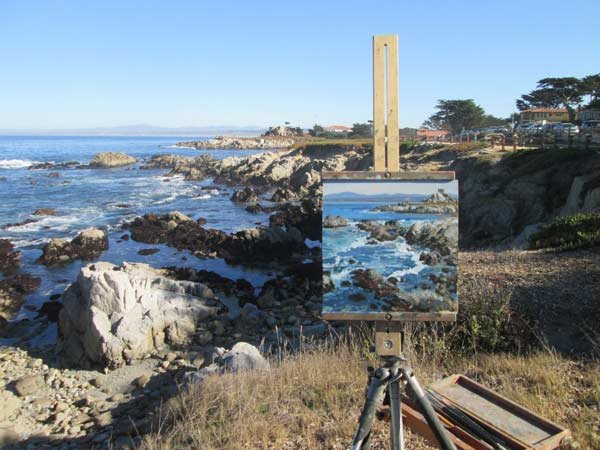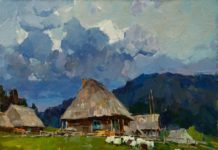In this series of articles, Utah artist J. Brad Holt talks about what artists are seeing as they look at the landscape. Holt studied geology in college and is attentive to what the rocks suggest in the scenes he paints.
This beautiful scene was not always part of California. It is but the last of a number of accretionary wedges that rode the East Pacific Plate into a collision with the western edge of the North American Plate, there to be scraped off and added to the west coast. Eventually the entirety of the East Pacific Plate was subducted and consumed. The remnants of the spreading center of the East Pacific Rise are now somewhere beneath the state of Nevada, which is undoubtedly contributing to the tensional forces that pulled the Great Basin apart. The boundary between the Pacific and North American plates is evolving into a transform fault boundary, creating great faults like the San Andreas, which will, in the fullness of geological time, bring Los Angeles and San Francisco face to face. If it sounds confusing, it is. It is the Wild West out here, a fact that prompted the essayist John McPhee to refer to the West as “a leather jacket geology in mirrored shades.”
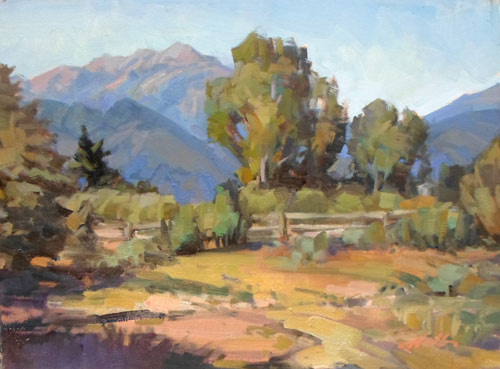
“Pastoral: Midway, Utah,” by J. Brad Holt, 2013, oil, 9 x 12 in.
In contrast, the stable, conservative geology of the East Coast seems tame, but it was not always so. The rolling ridges of the Appalachians were once a mighty mountain range to rival the Rockies or the Alps. 600 million years ago the Proto-Atlantic Ocean began to close. The clash of Africa and North America raised the Appalachians. When the present Atlantic Ocean began to rift apart, the range was torn apart in the vicinity of Nova Scotia, with the northern end of the range becoming the Caledonian mountains of Great Britain and Norway.
Geologists refer to the process of mountain building as orogenesis. There are several processes by which mountains are formed. All of these are governed by tectonic forces. Compressional forces at subduction zones along plate boundaries tend to raise the facing plate edges. This is exacerbated by partial melting of the subducted plate, which results in rising magma bodies. Some of this magma reaches the surface, causing extrusive volcanism, while some of it cools slowly at depth, creating intrusive granitic plutons. The combination of uplift, intrusion, and volcanism creates what are referred to as Andean type mountain ranges, adjacent to the convergent plate boundary. When island arcs, and continental fragments riding the subducting plate, arrive at the boundary, they are too light to be subducted, and they tend to accrete at the boundary, adding land to the facing plate. They are compressed and uplifted, warped and folded into another sort of mountain: the crazy-quilt geology of the coast range. When continents collide, all bets are off.
This is where big mountains are born. The northward drift of Africa closed the Tethys Sea and drove the continental fragment of Italy like a nail into the belly of Europe, creating the Alps. A similar confrontation between India and Asia raised the mighty Himalaya. Continents will not subduct. They compress, and bend, and fold and distort, rearing shattered fragments of rock high into the sky. Eventually subduction will cease, and the remains, now welded irrevocably, will begin to erode. This is what happened to the Appalachians, and the Urals.
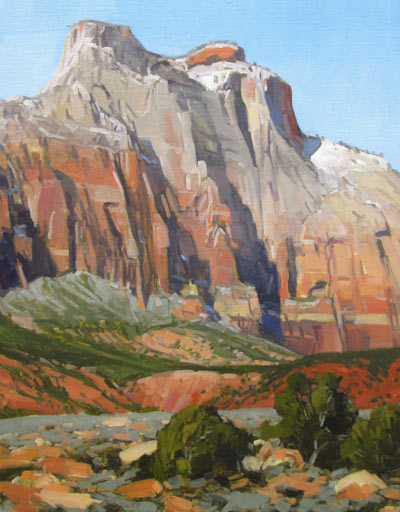
“At the Foot of Mt. Kinesava,” by J. Brad Holt, 2014, oil, 18 x 14 in.
Smaller mountain ranges are created by faulting. Faults come in three main flavors. Normal faults usually happen in tensional, or “pulling apart” environments. In this case, the hanging wall slips down and away from the facing wall. The numerous north-south mountains of the Basin and Range province of the American West were formed in this way, with the elevated up block becoming the range, or horst, and the down faulted block becoming the valley, or graben.
In reverse faults, the footwall is faulted down and forward with respect to the hanging wall, causing the hanging wall to uplift. This occurs in compressional environments, where the land is being pushed together. Strike-slip faults are where the faces of the fault are displaced laterally. When strike-slip faults are large enough to displace regions of crustal plates, they are referred to as transform faults.
The San Andreas Fault and the Great Glen Fault in Scotland are examples of transform faults. When rock is stressed below the threshold of its tensile strength, it may be folded rather than faulted. Up-arching folds are called anticlines, while trough-shaped down folds are called synclines. Most rock layers are under a certain amount of stress, and parallel fractures or zones of weakness, called joints, will develop. In surface weathering, these joints will erode more quickly, and they greatly influence the topography and appearance of the rock.
However these mountains are formed, they will not last forever. Eventually, through weathering, erosion, and mass wasting, they will be leveled. The sediments of their remains will be washed into vast sedimentary basins, called geosynclines. These basins sink lower and lower, as more sediments are added. Eventually, through heat and pressure, they will become rock.
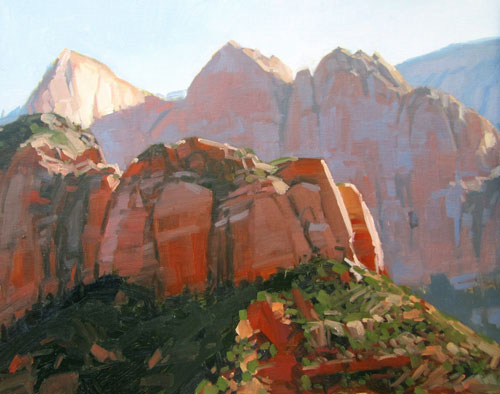
“The Crag — Kolob,” by J. Brad Holt, 2014, oil, 14 x 18 in.
The crust of the earth floats upon the mantle, and it wants to remain in equilibrium. Anything that pushes down on it will eventually rebound. This is called isostatic adjustment. Rock is elastic, but not that much. It takes a long time for the earth to rebound, and uplift those sedimentary layers, but eventually it happens. The geosyncline will stop filling with sediment, and begin to uplift through isostacy, to become a sedimentary plateau.
The stable interior cratons of the continents are called continental shields. They consist of very ancient, highly metamorphosed rock that has been worn almost flat through eons of erosion. One can glimpse, in the shields, the roots of vast mountain ranges, unremembered. The North American shield is exposed in the northeastern third of Canada. The most ancient rock on earth has been found here. But the entire shield is not of the same age. The oldest rock is found in the middle, around Hudson Bay, with progressively younger rock toward the margins. Similar findings have been made in exposed shield regions of other continents.
Earth scientists are beginning to understand that the continents have grown through accretion throughout the ages of the planet. What was once a terrane added to the edge of a continent will eventually become part of the shield, so metamorphosed as to be indistinguishable from the rest of the rock there.

